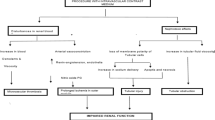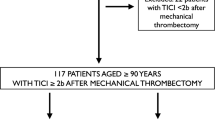Abstract
Purpose
To determine long-term renal function outcomes after renal cryoablation complicated by major hemorrhage requiring transarterial embolization compared to patients who underwent uncomplicated renal cryoablation without major hemorrhage.
Methods
Utilizing a matched cohort study design, retrospective review identified 23 patients who underwent percutaneous image-guided renal cryoablation complicated by major hemorrhage requiring ipsilateral transarterial embolization (TAE group) and a control group of 23 patients who underwent uncomplicated renal cryoablation matched 1:1 by age, gender and RENAL Nephrometry score at a single institution from 1/1/2005 to 12/31/2019. Primary outcome parameters included change in creatinine (mg/dl) and estimated glomerular filtration rate (ml/min/1.73 m2; eGFR) from baseline and were compared between TAE and control group using a paired t-test.
Results
There was a significantly higher proportion of patients on pre-ablation anticoagulation in the TAE v. control group (30% v. 4%; p = 0.047), but all patients were off anticoagulation and with normal coagulation parameters at the time of cryoablation. Otherwise there were no significant differences in clinical, renal tumor, Charlson co-morbidity index, baseline renal function or cryoablation parameters between the TAE and control group. In the post-ablation period, there was trend toward greater increase in creatinine from baseline to worst post-ablation creatinine in the TAE v. the control group (+ 0.5 ± 0.7 mg/dl v. 0.2 ± 0.1 mg/dl; p = 0.056). However, at a mean follow-up of 42.7 ± 35.7 months, there was no significant difference between the TAE and control group in creatinine (p = 0.68), eGFR (p = 0.60) or change from baseline in creatinine (p = 0.28), eGFR (p = 0.80) or CKD stage (p = 0.74). No patient required initiation of hemodialysis.
Conclusion
Selective transarterial embolization for post-renal cryoablation hemorrhage does not significantly affect long-term renal function compared to cryoablation alone. Pre-ablation anticoagulation despite normal coagulation at time of ablation may be a risk factor for post-ablation hemorrhage, and warrants further evaluation when considering pre-ablation embolization.




Similar content being viewed by others
References
National Comprehensive Cancer Network. Kidney Cancer. (Version 4.2021). Available from https://www.nccn.org/professionals/physician_gls/pdf/kidney.pdf. Accessed 23 June 2021.
Bamias A, Escudier B, Sternberg CN, Zagouri F, Dellis A, Djavan B, et al. Current Clinical Practice Guidelines for the Treatment of Renal Cell Carcinoma: A Systematic Review and Critical Evaluation. Oncologist. 2017;22(6):667-79.
Campbell SC, Novick AC, Belldegrun A, Blute ML, Chow GK, Derweesh IH, et al. Guideline for management of the clinical T1 renal mass. J Urol. 2009;182(4):1271-9.
Georgiades C, Rodriguez R. Renal tumor ablation. Tech Vasc Interv Radiol. 2013;16(4):230-8.
Krokidis ME, Orsi F, Katsanos K, Helmberger T, Adam A. CIRSE Guidelines on Percutaneous Ablation of Small Renal Cell Carcinoma. Cardiovasc Intervent Radiol. 2017;40(2):177-91.
Atwell TD, Callstrom MR, Farrell MA, Schmit GD, Woodrum DA, Leibovich BC, et al. Percutaneous renal cryoablation: local control at mean 26 months of followup. J Urol. 2010;184(4):1291-5.
Mason RJ, Atwell TD, Lohse C, Bhindi B, Weisbrod A, Boorjian SA, et al. Renal functional outcomes in patients undergoing percutaneous cryoablation or partial nephrectomy for a solitary renal mass. BJU Int. 2017;120(4):544-9.
Ramani AP, Desai MM, Steinberg AP, Ng CS, Abreu SC, Kaouk JH, et al. Complications of laparoscopic partial nephrectomy in 200 cases. J Urol. 2005;173(1):42-7.
Olweny EO, Park SK, Tan YK, Best SL, Trimmer C, Cadeddu JA. Radiofrequency ablation versus partial nephrectomy in patients with solitary clinical T1a renal cell carcinoma: comparable oncologic outcomes at a minimum of 5 years of follow-up. Eur Urol. 2012;61(6):1156-61.
Thompson RH, Atwell T, Schmit G, Lohse CM, Kurup AN, Weisbrod A, et al. Comparison of partial nephrectomy and percutaneous ablation for cT1 renal masses. Eur Urol. 2015;67(2):252-9.
Andrews JR, Atwell T, Schmit G, Lohse CM, Kurup AN, Weisbrod A, et al. Oncologic Outcomes Following Partial Nephrectomy and Percutaneous Ablation for cT1 Renal Masses. Eur Urol. 2019;76(2):244-51.
Atwell TD, Carter RE, Schmit GD, Carr CM, Boorjian SA, Curry TB, et al. Complications following 573 percutaneous renal radiofrequency and cryoablation procedures. J Vasc Interv Radiol. 2012;23(1):48-54.
Kakarala B, Frangakis CE, Rodriguez R, Georgiades CS. Hemorrhagic Complications of Percutaneous Cryoablation for Renal Tumors: Results from a 7-year Prospective Study. Cardiovasc Intervent Radiol. 2016;39(11):1604-10.
Schmit CH, Callstrom MR, Boorjian SA, Johnson MP, Atwell TD, Kurup AN, et al. A Comparison of Bleeding Complications in Patients Undergoing Percutaneous Renal Cryoablation Using Cryoprobes with and without Heat-Based Track Ablation. J Vasc Interv Radiol. 2018;29(6):874-9.
Guneyli S, Gok M, Bozkaya H, Cinar C, Tizro A, Korkmaz M, et al. Endovascular management of iatrogenic renal arterial lesions and clinical outcomes. Diagn Interv Radiol. 2015;21(3):229-34.
Hyams ES, Pierorazio P, Proteek O, Sukumar S, Wagner AA, Mechaber JL, et al. Iatrogenic vascular lesions after minimally invasive partial nephrectomy: a multi-institutional study of clinical and renal functional outcomes. Urology. 2011;78(4):820-6.
Loffroy R, Guiu B, Lambert A, Mousson C, Tanter Y, Martin L, et al. Management of post-biopsy renal allograft arteriovenous fistulas with selective arterial embolization: immediate and long-term outcomes. Clin Radiol. 2008;63(6):657-65.
Mavili E, Donmez H, Ozcan N, Sipahioglu M, Demirtas A. Transarterial embolization for renal arterial bleeding. Diagn Interv Radiol. 2009;15(2):143-7.
Muller A, Rouviere O. Renal artery embolization-indications, technical approaches and outcomes. Nat Rev Nephrol. 2015;11(5):288-301.
Perini S, Gordon RL, LaBerge JM, Kerlan RK, Jr., Wilson MW, Feng S, et al. Transcatheter embolization of biopsy-related vascular injury in the transplant kidney: immediate and long-term outcome. J Vasc Interv Radiol. 1998;9(6):1011-9.
Sam K, Gahide G, Soulez G, Giroux MF, Oliva VL, Perreault P, et al. Percutaneous embolization of iatrogenic arterial kidney injuries: safety, efficacy, and impact on blood pressure and renal function. J Vasc Interv Radiol. 2011;22(11):1563-8.
Woodrum DA, Atwell TD, Farrell MA, Andrews JC, Charboneau JW, Callstrom MR. Role of intraarterial embolization before cryoablation of large renal tumors: a pilot study. J Vasc Interv Radiol. 2010;21(6):930-6.
Collins CS, Eggert CH, Stanson AJ, Garovic VD. Long-term follow-up of renal function and blood pressure after selective renal arterial embolization. Perspect Vasc Surg Endovasc Ther. 2010;22(4):254-60.
Jacobson AI, Amukele SA, Marcovich R, Shapiro O, Shetty R, Aldana JP, et al. Efficacy and morbidity of therapeutic renal embolization in the spectrum of urologic disease. J Endourol. 2003;17(6):385-91.
Poulakis V, Ferakis N, Becht E, Deliveliotis C, Duex M. Treatment of renal-vascular injury by transcatheter embolization: immediate and long-term effects on renal function. J Endourol. 2006;20(6):405-9.
Patel HD, Pierorazio PM, Johnson MH, Sharma R, Iyoha E, Allaf ME, et al. Renal Functional Outcomes after Surgery, Ablation, and Active Surveillance of Localized Renal Tumors: A Systematic Review and Meta-Analysis. Clin J Am Soc Nephrol. 2017;12(7):1057-69.
Kutikov A, Uzzo RG. The R.E.N.A.L. nephrometry score: a comprehensive standardized system for quantitating renal tumor size, location and depth. J Urol. 2009;182(3):844-53.
Schmit GD, Schenck LA, Thompson RH, Boorjian SA, Kurup AN, Weisbrod AJ, et al. Predicting renal cryoablation complications: new risk score based on tumor size and location and patient history. Radiology. 2014;272(3):903-10.
de Graaf MA, Jager KJ, Zoccali C, Dekker FW. Matching, an appealing method to avoid confounding? Nephron Clin Pract. 2011;118(4):c315-8.
Marconi L, Dabestani S, Lam TB, Hofmann F, Stewart F, Norrie J, et al. Systematic Review and Meta-analysis of Diagnostic Accuracy of Percutaneous Renal Tumour Biopsy. Eur Urol. 2016;69(4):660-73.
Harris PA, Taylor R, Minor BL, Elliott V, Fernandez M, O'Neal L, et al. The REDCap consortium: Building an international community of software platform partners. J Biomed Inform. 2019;95:103208.
Harris PA, Taylor R, Thielke R, Payne J, Gonzalez N, Conde JG. Research electronic data capture (REDCap)--a metadata-driven methodology and workflow process for providing translational research informatics support. J Biomed Inform. 2009;42(2):377-81.
Li J, Li Z, Jiao DC, Si G, Zhou X, Li Y, et al. Clinical outcomes after selective renal artery embolization combined with DynaCT-guided microwave ablation for T1a renal-cell carcinoma: case series. Clin Genitourin Cancer. 2021;19(1):e1-e5.
Austin PC. An Introduction to Propensity Score Methods for Reducing the Effects of Confounding in Observational Studies. Multivariate Behav Res. 2011;46(3):399-424.
Funding
None.
Author information
Authors and Affiliations
Corresponding author
Ethics declarations
Conflict of interest
No conflicts of interest related to content of manuscript.
Additional information
Publisher's Note
Springer Nature remains neutral with regard to jurisdictional claims in published maps and institutional affiliations.
Rights and permissions
About this article
Cite this article
McElroy, K.M., Reisenauer, C.J., Welch, B.T. et al. Long-term renal function outcomes after renal cryoablation complicated by major hemorrhage requiring selective transarterial embolization. Abdom Radiol 46, 4898–4907 (2021). https://doi.org/10.1007/s00261-021-03182-w
Received:
Revised:
Accepted:
Published:
Issue Date:
DOI: https://doi.org/10.1007/s00261-021-03182-w




